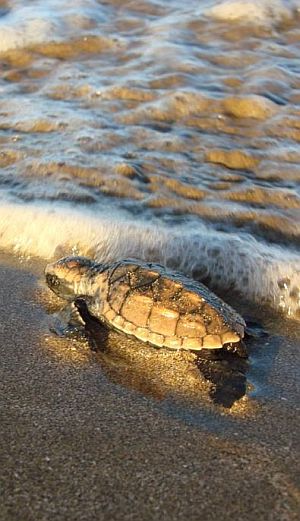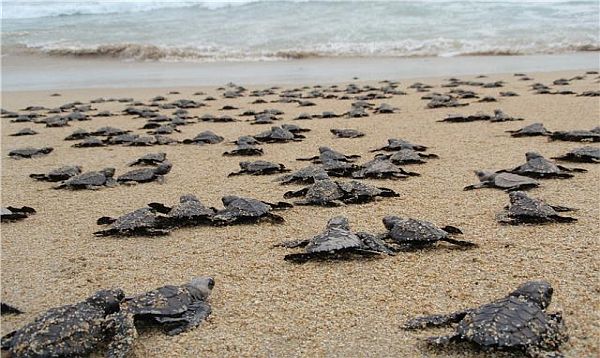Puerto Vallarta, Jalisco, Mexico - The Bay of Banderas is home to thousands of Olive Ridley Sea Turtles, whom each year return to the beaches on which they were born to lay their eggs - one of Puerto Vallarta's most visible and interesting ecological cycles.
As the sea turtle nesting takes place just outside the doors of Puerto Vallarta's finest resorts, the local hotel industry has been involved in the protection effort, running marine turtle conservation and protection programs, with the support of professional marine biologists and the city's Department of Environment and Ecology department, for the last thirty-five years.
 |
Many Puerto Vallarta resorts, including the Casa Magna Marriott, Velas Vallarta, Dreams and Hotel Barcelo, as well as some smaller hotels, such as Hotel Rosita and El Pescador, provide their guests with a unique opportunity to participate in this once-in-a-lifetime experience.
Since the daily activities of a beach resort are hardly a safe place for a turtle nest, every year from June through December, guests are encouraged to spend time with a local biologist, learn more about the endangered species and, at some hotels, participate in nightly beach patrols in search of turtle nests, under the guidance of a marine biologist.
When a nest is found, participants help gather the eggs and transport them, still in their nests, to sea turtle nurseries for incubation. Approximately 45 days later, the baby turtles emerge from their eggs and are ready to be released into the sea.
For those interested in helping to set the hatchlings free, turtle releases run every night at most Vallarta resorts. The resort's recreational staff takes the opportunity to familiarize participants with the Olive Ridley turtle, explaining their life cycle and physical characteristics, while creating environmental awareness and encouraging others to help save them.
Afterwards, participants are invited to name the turtles, wish them luck and set them free. The turtles are returned to the sea at the edge of the resort's beach, where some of them will return a decade later to start the process all over again.
There are also a number of ecological groups that run turtle camps and nurseries in the greater Banderas Bay area, where you can help newborn turtles through the first steps of their lives. Among them are: Campamentos Tortugueros Puerto Vallarta, a 2 km stretch of beach from Playa de Oro to Playa los Tules in the northern part of Puerto Vallarta; and, in Riviera Nayarit, Grupo Ecologico de la Costa Verde's Marine Turtle Nursery, Platanitos Turtle Camp and Grupo Ecologico de Nayarit's Playa el Naranjo.
During the summer and fall months, travelers can volunteer or go on tours of these nurseries and nesting sites to learn about the fascinating life cycle of sea turtles for just one night or by participating in a two-month-long volunteer project, subject to availability. For more information, visit project-tortuga.org.
Before the development of programs such as these, only 40% of the eggs that were laid along the shores of Banderas Bay survived, but today, thanks to programs such as these, almost 96% of the eggs deposited are incubated successfully.
Everyone is invited to come to Puerto Vallarta this summer to witness this wonder of nature, while participating in the conservation of endangered marine turtles. Without a doubt, to be in such close contact with nature is an unforgettable experience for all ages.


